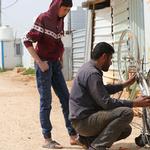Emergency Urbanism in Sabra, Beirut.
Since the mid-1980s, generations of displaced people have sought refuge in the ramshackle buildings that were once the Gaza-Ramallah Hospital, a multi-story hospital complex built by the Palestinian Liberation Organization (PLO). Damaged during the civil war, today the buildings blend in with the run-down Sabra-Shatila neighbourhood in Beirut’s “misery belt.” This paper charts the buildings’ history and main characters: the lodgers, landlords, and gatekeepers who respectively lease, rent, and control the dilapidated buildings’ dark corridors, cramped flats, and garbage-strewn stairways. The multi-story buildings are examples of emergency urbanism whereby displaced people seek refuge in cities, and their story can be read as a vertical migration history of people escaping conflict, displacement, and destitution. Examining the buildings as archives of spatial and political histories provides a genealogy of displacement and emplacement that can inform the study of emergency urbanism and point to solutions in cities for refugees lacking access to affordable housing.
https://doi.org/10.1163/25891715-00102003







